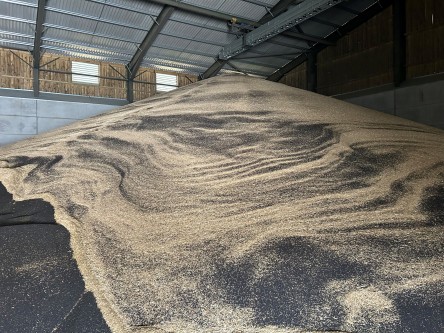
UK OSR yields are set to surpass the long-standing record of 3.91 t/ha, set all the way back in 2011, and possibly even break through the 4.0 t/ha barrier.
United Oilseeds predicts an average yield in the range of 3.95–4.0 t/ha, driven by improved genetics, a season of favourable weather, and reduced cabbage stem flea beetle pressure.
With a 227,000-ha harvested area, this step-up in productivity is remarkable. At the long-term average of 3.11 t/ha, we’d have seen around 700,000 tonnes of crop. Instead, at 4.0 t/ha, the total rises to almost 900,000 tonnes, a 200,000-tonne gain in a single season. That’s worth nearly £100 million in additional UK GDP before even considering the knock-on benefits.
And those knock-ons are substantial:
- Haulage: 200,000 tonnes is almost 7,000 extra lorry journeys, worth another £3 million to UK hauliers.
- Jobs & services: More tractor movements, more grain to store, sample, insure, and trade. That’s work for truck drivers, lab technicians, merchants, brokers, and processors.
- Industry levies: More tonnage means more AHDB funding for research and industry development such as the new CSFB Research+ project.
This is exactly the vision behind the OSR Reboot campaign - led by United Oilseeds - uniting the industry to rebuild the UK’s only homegrown source of both vegetable oil and high-protein animal feed and thus supporting economic growth, food security and countrywide biodiversity.
James Warner, Managing Director of United Oilseeds, said: “Our members are delighted to see yields lift this year, with the benefits of the OSR Reboot work now coming through. For those prepared to give the crop the focus it deserves, oilseed rape continues to prove why so many still regard it as the number one break crop. Lower flea beetle pressure, favourable growing conditions, and major advances from seed breeders have all played their part. We’re optimistic that this will encourage more growers to bring OSR back into their plans for the season ahead.”
How the figures translate into the Reboot pillars
Pillar 1: Food Security
Producing an extra 200,000 tonnes of homegrown seed strengthens the UK’s ability to feed itself and reduces reliance on volatile global supply chains. Every tonne grown here is one less we need to source from overseas, improving resilience against market disruption and safeguarding supplies for both food and feed.
- That volume equates to around 90,000 tonnes of rapeseed oil or roughly 90 million bottles produced entirely on British farms.
- On the feed side, it’s over 100,000 tonnes of rapemeal, enough for 100 million daily rations for cattle. With 2.63 million cows in the UK, that’s the equivalent of 38 extra days’ worth of high-protein feed per animal!
In short, more British oil, more British protein, less reliance on overseas shipping lanes, and greater control over our own supply.
Pillar 2: Economic Growth
The surge in UK-grown OSR doesn’t just strengthen food security — it also boosts the nation’s economy. By replacing imports with homegrown seed, we improve the balance of trade while keeping more value within UK agriculture and allied industries. The economic ripple effect from this year’s uplift is significant:
- £100 million in extra crop value.
- £3 million in haulage revenue.
- Around 14–15 full-time truck driving jobs equivalent from transport alone.
- A further £4 million in value from storage, sampling, and associated services.
From farmers to hauliers, lab techs to processors, the yield increase injects new energy and income into the rural economy.
Pillar 3: Reversing Biodiversity Decline
OSR’s bright yellow flowers are more than just a visual marker of spring. They provide a vital food source for pollinators at a key time of year, particularly early-season bees and other insects. This year’s crop looked exceptional in flower, and greater flowering area and density mean more nectar and pollen available in the landscape.
Looking ahead: Gross margin potential
With farmgate OSR prices holding steady in the £370 - £420 range and other commodity prices remaining flat, OSR will be the top gross-margin crop on many arable farms in 2025.
On a yield of 4.0 t/ha at £400/t, OSR revenue hits £1,600/ha. Even accounting for higher variable costs, gross margins north of £1,000/ha are achievable, comfortably outpacing many wheat budgets this season. Stable prices and record-breaking yields mean the crop is delivering on all three OSR Reboot pillars while also rewarding growers financially.
Commenting on how the sector can capitalise on current momentum, Mr Warner said: “For growers wanting practical tips, the joint AHDB and OSR Reboot Top 10 Management Strategies for Combatting CSFB are there for everyone — these principles have been agreed across the industry, and with collective effort in the field, we can ensure the future viability of this vital homegrown crop. With the considerable investment in the new CSFB Research+ project, it’s clear that the industry is fully committed to OSR’s future.”
